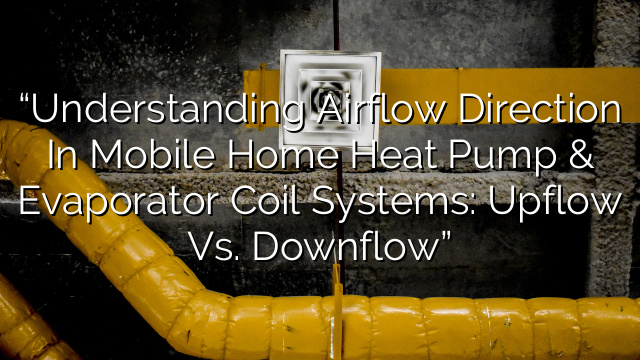Understanding Airflow Direction in Mobile Home Heat Pump & Evaporator Coil Systems: Upflow vs. Downflow
Mobile homes require efficient heating and cooling systems to maintain a comfortable indoor environment. When it comes to heat pumps and evaporator coil systems in mobile homes, airflow direction plays a crucial role in their performance and efficiency. In this article, we will explore the differences between upflow and downflow airflow direction in mobile home heat pump and evaporator coil systems, and how they affect the overall functionality of these systems.
What is Airflow Direction?
Before delving into the differences between upflow and downflow airflow direction, it’s important to understand what airflow direction refers to in the context of HVAC systems. Airflow direction refers to the path that air takes within the heating or cooling system as it is being processed.
Upflow Airflow Direction
Upflow is a commonly used airflow direction in mobile home heat pump and evaporator coil systems. In an upflow system, the air intake is located at the bottom of the system, near the air handler or furnace, and the conditioned air is discharged from the top of the system. As the name suggests, the air flows in an upward direction.
This type of airflow direction is ideal for certain mobile homes where the available space for the HVAC system is limited. By flowing the air in an upward direction, the system can make use of the vertical space effectively. Additionally, having the air intake at the bottom and the discharge at the top helps prevent any interference with furniture or other objects in the room.
Downflow Airflow Direction
Downflow is another common airflow direction used in mobile home heat pump and evaporator coil systems. In a downflow system, the air intake is located at the top of the system, and the conditioned air is discharged from the bottom. As the name suggests, the air flows in a downward direction.
This type of airflow direction is often preferred in mobile homes where there’s ample space available above the HVAC system. By flowing the air in a downward direction, the system can take advantage of the natural tendency of warm air to rise, helping to distribute the conditioned air more efficiently throughout the space. The downflow direction can also minimize the buildup of dust and other particles on the ceiling.
Differences in Installation
The primary difference between upflow and downflow airflow direction lies in the installation process. In an upflow system, the unit is typically installed in a closet or other enclosed space, with the air intake at the bottom and the discharge at the top. On the other hand, a downflow system is usually installed in the attic or a raised platform, with the air intake at the top and the discharge at the bottom.
During installation, it’s crucial to ensure that the ductwork and airflow direction are set up correctly to maximize the system’s efficiency and performance. Consulting with a professional HVAC technician is recommended to ensure proper installation and airflow direction selection.
Impact on Efficiency and Performance
The airflow direction in a mobile home heat pump and evaporator coil system can have a significant impact on its efficiency and performance. It affects the distribution of conditioned air, energy consumption, and overall comfort level within the home.
In an upflow system, the air is distributed from the top, allowing it to flow downward and reach all areas of the living space. This can help provide more even heating and cooling throughout the home. On the other hand, a downflow system utilizes the natural tendency of warm air to rise, which can help distribute the conditioned air more efficiently. However, it may not be as effective in providing even temperatures if there are lower ceilings or obstructions that prevent proper air circulation.
Energy consumption is also influenced by the airflow direction. An upflow system may require more energy to push the air upward, while a downflow system may require more energy to pull the air downward. The impact on energy consumption, however, may vary depending on the specific configuration and quality of the HVAC system.
FAQ Section
1. Which airflow direction is better for mobile homes?
Both upflow and downflow airflow directions have their advantages and disadvantages. The choice depends on the specific needs of your mobile home and the available space for installation. Consult with a professional HVAC technician to determine the best airflow direction for your mobile home.
2. Can the airflow direction in a mobile home HVAC system be changed?
Yes, it is possible to change the airflow direction in a mobile home HVAC system. However, it may require significant modifications to the system and its installation, and it’s best to consult with a professional HVAC technician to assess the feasibility and potential impact on the system’s performance.
3. How can I ensure proper airflow direction in my mobile home HVAC system?
To ensure proper airflow direction, it’s recommended to consult with a professional HVAC technician during the installation process. They will assess your mobile home’s layout, available space, and other factors to determine the best airflow direction and set up the system accordingly.
4. Can I change the airflow direction in my existing mobile home HVAC system?
Changing the airflow direction in an existing mobile home HVAC system may be possible, but it depends on the specific system and its configuration. Consult with a professional HVAC technician to assess the feasibility of changing the airflow direction in your system.
5. What other factors should I consider when choosing an airflow direction for my mobile home HVAC system?
Aside from the available space and layout of your mobile home, you should also consider factors such as insulation, ceiling height, the presence of obstructions or furniture, and your specific heating and cooling needs. A professional HVAC technician can assess all these factors and provide expert advice on choosing the right airflow direction for your system.


